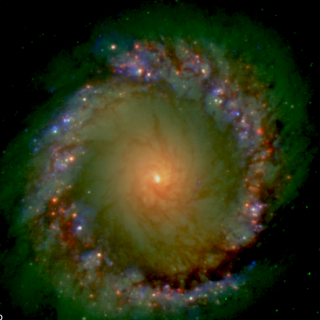Bibcode
Mezcua, M.; Prieto, M. A.; Fernández-Ontiveros, J. A.; Tristram, K.; Neumayer, N.; Kotilainen, J. K.
Referencia bibliográfica
Monthly Notices of the Royal Astronomical Society, Volume 452, Issue 4, p.4128-4144
Fecha de publicación:
10
2015
Número de citas
22
Número de citas referidas
21
Descripción
The distribution of warm molecular gas (1000-3000 K), traced by the
near-IR H2 2.12 μm line, has been imaged with a resolution
<0.5 arcsec in the central 1 kpc of seven nearby Seyfert galaxies. We
find that this gas is highly concentrated towards the central 100 pc and
that its morphology is often symmetrical. Lanes of warm H2
gas are observed only in three cases (NGC 1068, NGC 1386 and Circinus)
for which the morphology is much wider and extended than the dust
filaments. We conclude that there is no one-to-one correlation between
dust and warm gas. This indicates that, if the dust filaments and lanes
of warm gas are radial streaming motions of fuelling material, they must
represent two different phases of accretion: the dust filaments
represent a colder phase than the gas close to the nucleus (within
˜100 pc). We predict that the morphology of the nuclear dust at
these scales should resemble that of the cold molecular gas (e.g. CO at
10-40 K), as we show for CenA and NGC 1566 by Atacama Large
Millimeter/submillimeter Array (ALMA) observations, whereas the inner
H2 gas traces a much warmer phase of material identified with
warmer (40-500 K) molecular gas such as CO(6-5) or HCN (as shown by ALMA
for NGC 1068 and NGC 1097). We also find that X-ray heating is the most
likely dominant excitation mechanism of the H2 gas for most
sources.
Proyectos relacionados

Centros de Galaxias a Escalas de Parsecs y Técnicas de Alta Resolución Espacial
Proyecto enfocado al estudio en el IR del núcleo de las galaxias más cercanas con resoluciones espaciales en el rango de 1 a 10 pc. Estas resoluciones espaciales, accesibles con los grandes telescopios de tierra usando técnicas frontera de observación, son por primera vez comparables a las que se obtienen rutinariamente con HST en el óptico y VLBI
Almudena
Prieto Escudero